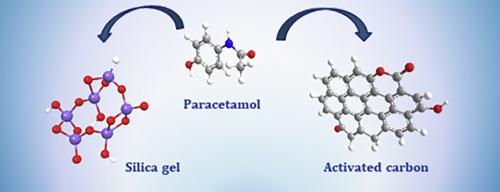Journal of Contaminant Hydrology ( IF 3.6 ) Pub Date : 2020-11-14 , DOI: 10.1016/j.jconhyd.2020.103739 Agustín Spaltro , Matías N. Pila , Diego D. Colasurdo , Emilia Noseda Grau , Gabriel Román , Sandra Simonetti , Danila L. Ruiz

|
The presence of pharmaceutical residues in the aquatic environment is a known problem worldwide. Paracetamol is widely used as an analgesic and antipyretic. Its high consumption implies a continuous discharge in aqueous environments through industrial and domestic wastewater that requires mitigation and remediation strategies.
The aim of the present study was to analyse the removal of the paracetamol from aqueous solutions using the adsorption technique. For this, three commercial adsorbents with different textural properties were used: two activated carbons (CAT and CARBOPAL) and silica gel. A series of batch adsorption experiments were conducted at different values of pH (3.0, 7.0 and 10.5) and ionic strength (0.01, 0.5 and 1 M) to investigate the effects on the removal of paracetamol from the aqueous solution. In addition, we investigated the adsorption mechanism using the density functional theory.
Adsorption was found to be higher in the acidic pH range, as varying pH showed significant influence on the surface charge of the adsorbents and degree of ionization of the paracetamol. Adsorption capacity of the adsorbents increased with an increase in the ionic strength of solution. At 25 °C, pH 3, ionic strength 1 M, 167 mg L−1 of adsorbent and initial concentrations of paracetamol between 25 and 150 mg L−1, the maximum adsorption capacity was 560 mg g−1, 450 mg g−1 and 95 mg g−1, for CAT, CARBOPAL and silica respectively. The experimental kinetic data fitted well the pseudo-second order model and the equilibrium isotherm data the Langmuir model. The functional density theory methods provided atomistic details about paracetamol adsorbed on the surface of carbon and silica through molecular modeling.
中文翻译:

用活性炭和二氧化硅从水溶液中除去扑热息痛。实验与计算研究
在水生环境中药物残留的存在是全世界已知的问题。扑热息痛广泛用作镇痛药和退烧药。它的高消耗量意味着通过工业和生活废水在水环境中的持续排放,这需要缓解和修复策略。
本研究的目的是分析使用吸附技术从水溶液中对乙酰氨基酚的去除。为此,使用了三种具有不同质地特性的商业吸附剂:两种活性炭(CAT和CARBOPAL)和硅胶。在不同的pH值(3.0、7.0和10.5)和离子强度(0.01、0.5和1 M)下进行了一系列分批吸附实验,以研究对水溶液中扑热息痛的去除效果。此外,我们使用密度泛函理论研究了吸附机理。
发现在酸性pH范围内的吸附更高,因为变化的pH对吸附剂的表面电荷和对乙酰氨基酚的离子化程度有显着影响。吸附剂的吸附能力随着溶液离子强度的增加而增加。在25℃,pH为3,离子强度1M,167毫克的L -1吸附剂和25和150毫克的L之间的对乙酰氨基酚初始浓度的-1,最大吸附容量为560毫克克-1,450毫克克-1和95 mg g -1分别用于CAT,CARBOPAL和二氧化硅。实验动力学数据很好地拟合了伪二阶模型,平衡等温线数据拟合了Langmuir模型。功能密度理论方法通过分子模拟提供了有关扑热息痛吸附在碳和二氧化硅表面上的原子细节。


























 京公网安备 11010802027423号
京公网安备 11010802027423号